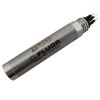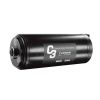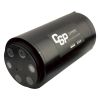Turner Designs Cyclops-7F Submersible Sensors
Features
- Interfaces easily with most data collection platforms using 0-5 VDC output
- Very low power consumption allows for extended remote deployments
- Interfaces with DataBank Handheld Data Logger and Cyclops-7 Logger
- Free ground shipping
- Expedited repair and warranty service
- Lifetime technical support
- More
Overview
The Turner Designs Cyclops-7F submersible fluorometer sensors are designed for integration into remote data collection and telemetry platforms. The sensors offer a unique combination of performance and size, making them very attractive for freshwater, coastal, and oceanographic environments. Cyclops-7F sensors are configured and factory scaled for the specific analysis of turbidity, chlorophyll, phycocyanin, phycoerythrin, rhodamine dye, fluorescein dye, CDOM, crude oil, optical brighteners, PTSA dye, or tryptophan.
Durable
The Cyclops-7F sensor features a locking sleeve Impulse connector with cable options available from 2 feet to 50 meters. The rugged stainless steel construction is designed to withstand most environmental conditions. Common applications include turbidity dredge monitoring, algal bloom notification, and dye tracer studies.
In The News
Wildfire smoke alters a lake's ecology from the top to the bottom of the food chain
Wildfires have been big news the last couple of years. Australia’s wildfires in 2019 and 2020 and the Amazon rainforest fires in 2021 made headlines around the world. The American west has had record-breaking burns in recent years, blanketing cities in dangerous amounts of smoke and sending haze across the continent to the east coast. While smoke has clear and apparent effects on the sky, new research finds it changed the ecology of Castle Lake, a freshwater lake in California, in 2018. “There are some studies that have analyzed the effect of human health in respiration with the smoke of wildfire,” said Facundo Scordo, a postdoctoral researcher at the Global Water Center of the University of Nevada—Reno.
Read More2025 Essential Water Monitoring Gear
Stay ahead of the curve with five of the top water monitoring products for 2025. Technological advancements and manufacturing innovations are leading to better quality data, improved price points, and enhanced user experience. And, while the ‘essentials’ list includes several new products, two tried-and-true measurement instruments continue to take a top spot for portable instrumentation. These five products were developed by industry-leading suppliers, and in addition to extensive manufacturer testing, our science team tested and verified each instrument’s performance at the Fondriest Center for Environmental Studies .
Read MoreYSI ProDSS Multi-Parameter Water Quality Meter Review
There's no shortage of options when it comes to water quality monitoring equipment. If you're looking for an all-in-one multi-parameter sampling meter, then the YSI ProDSS is a prime choice. Along with its field-rugged construction, backlit display, rechargeable battery, a wide selection of cable lengths and a long list of measurement parameters, the meter offers the latest in smart sensor technology. Constructed of titanium and laser welded, the smart sensors offer superior performance in fresh, brackish and saltwater applications. Upon connection, the smart sensors are automatically displayed on the meter. With internally stored calibration constants, any sensor can plug into any port and provide accurate data in just seconds.
Read More































